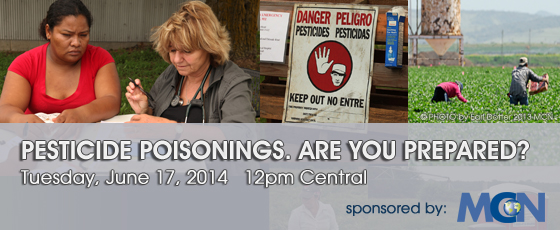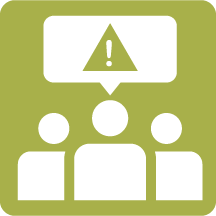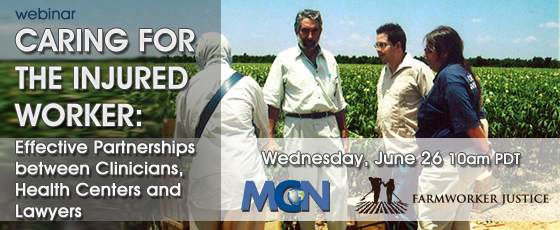Este diccionario ilustrado bilingüe de MCN, "Seguridad en Palabras/ Safety in Words", muestra los peligros que hay en el lugar de trabajo y las mejores prácticas para la salud y la seguridad en la agricultura. Desarrollado con el apoyo del Programa de Subvenciones Susan Harwood de OSHA, este recurso refuerza el vocabulario en inglés de los trabajadores que hablan español lo que ayudará a prevenir lesiones en la agricultura.
DATE RECORDED: Wednesday, June 17, 2014
PRESENTED BY: Matthew Keifer, MD, MPH, Dean Emanuel Endowed Chair/Director National Farm Medicine Center
 | |
 MCN’s Environmental and Occupational Health Programs
MCN’s Environmental and Occupational Health Programs
Learn more about MCN’s training and technical assistance programs to help clinicians and health centers improve the recognition and management of pesticide exposures and other environmental/occupational health conditions.
Mistakes can be dangerous. Accurate identification of pesticides responsible for a patient's illness is important to avoid iatrogenic errors with respect to acute treatment. Join us for an important webinar that will focus on key decision points in the diagnosis of pesticide exposures and emphasize the usefulness of the newly revised resource for clinicians - The Recognition and Management of Pesticide Poisonings, 6th ed. Through interactive case studies, this webinar will illustrate effective recognition and treatment of patients over exposed to pesticides.
The webinar, sponsored by Migrant Clinicians Network, the National Farm Medicine Center and AgriSafe Network features Dr. Keifer, a board certified occupational medicine specialist and internationally renowned researcher regarding pesticides and agricultural health and safety. For over 30 years, Dr. Keifer has focused his clinical practice and research largely on farmworkers.
SPONSORED BY: AgriSafe Network, Migrant Clinicians Network, and the National Farm Medicine Center
OBJECTIVES: Participants will be able to:
- Better recognize the signs and symptoms of pesticide overexposure
- Identify key decision points in diagnosing pesticide exposures
- Demonstrate an understanding of how to use The Recognition and Management of Pesticide Poisonings, 6th ed. in a clinical setting
We encourage all participants to order The Recognition and Management of Pesticide Poisonings, 6th ed. prior to attending this webinar. Order here. PDF versions are also available at http://www2.epa.gov/pesticide-worker-safety/recognition-and-management-pesticide-poisonings
If you have experienced any trouble ordering your copy please contact: kbrennan@migrantclinician.org
CLINICAL TOOLS & RESOURCES |
|
PATIENT EDUCATION MATERIALS |
|
ARCHIVED WEBINARS & TRAINING RESOURCES |
|
LOCAL PESTICIDE RESOURCES |
The following will provide information regarding the pesticides used in your areas:
|
- http://migrantclinician.adobeconnect.com/p77irjl7cvq/
- http://www.marshfieldclinic.org/nfmc/
- http://www.agrisafe.org/
- http://1.usa.gov/1aF9rHY
- http://www2.epa.gov/pesticide-worker-safety/recognition-and-management-pesticide-poisonings
- http://1.usa.gov/1fFUSZm
- http://bit.ly/1imO43V
- http://npic.orst.edu/
- http://www.aapcc.org/
- http://extoxnet.orst.edu/
- http://www.pesticidemededucation.com/
- http://www.extension.umn.edu/agriculture/pesticide-safety/program-team/
- http://www3.extension.umn.edu/county
- http://web.extension.illinois.edu/psep/about/psepteam.cfm
- http://web.extension.illinois.edu/state/findoffice.cfm
Three concise and effective environmental/occupational health screening questions for the primary care provider. English and Spanish. MCN, 2014.
An EHR-friendly version of these screening questions was developed through MCN's Workers & Health Program. This can be used as a reference for integration into the health center's Electronic Health Record.
- EOHScreeningQs_2014Nov.pdf (3.99 MB)
- EOHScreeningQs_EHR_2014Nov.pdf (4.49 MB)
Print, cut, and distribute this handy bookmark to providers who treat migrant and seasonal farmworker patients. The bookmark includes links and a qr code to connect you to pesticide - related clinical tools and resources. In addition, we've included some useful phone numbers in case of a pesticide emergency.
You can also use the bookmark to keep handy the Health Network phone number to be sure your patients on the move remain in care.
- EOHbookmark_final_92013.pdf (722.68 KB)
Reducing exposure to toxic environmental agents is a critical area of intervention for obstetricians, gynecologists, and other reproductive health care professionals. The evidence that links exposure to toxic environmental agents and adverse reproductive and developmental health outcomes is sufficiently robust, and the American College of Ostetricicans and Gynecologists and the American Society for Reproductive Medicine join leading scientists and other clinical practitioners in calling for timely action to identify and reduce exposure to toxic envrionmental agents while addressing the consequences of such exposure.
- ACOG UCSF2013.pdf (378.64 KB)
This colorful bilingual comic addresses workers' compensation and immigrant dairy farm workers’ rights and responsibilities. It tells the story of a Mexican dairy farm worker who is injured on the job and the steps he and his employer take to make sure he receives his benefits, and the farm improves its safety.
- DairyWrkrRightsWrkComp_ENG2016_web.pdf (7.78 MB)
- DairyWrkrRightsWrkComp_ESP2016_web.pdf (7.92 MB)
- COMIC - Safety and Health on the Farm - New Mexico - English.pdf (3.4 MB)
- COMIC - Safety and Health on the Farm - New Mexico - Spanish.pdf (3.41 MB)
- COMIC - Safety and Health on the Farm - New York - English.pdf (3.45 MB)
- COMIC - Safety and Health on the Farm - New York - Spanish.pdf (3.46 MB)
- COMIC - Safety and Health on the Farm -Minnesota -English.pdf (7.78 MB)
- COMIC - Safety and Health on the Farm - Minnesota - Spanish_0.pdf (7.91 MB)
MCN's Director of Environmental and Occupational Health, Amy K. Liebman, appeared on the radio broadcast Epicenter: West Marin Issues on KWMR 90.5 FM to talk pesticides and the Worker Protection Standard. Liebman was joined by Hector Sanchez of the Labor Council for Latin American Advancement. Host Frederick Smith discusses with Liebman and Sanchez a variety of pesticide-related issues, including protections for farmworkers and their families, farmworkers' risks of pesticide exposures, how pesticides are regulated, their health effects on farmworkers and their families, and what healthcare providers can do to mitigate, diagnose, manage, and report pesticide exposures.
During the interview Liebman referenced the Agricultural Health Study, which is available here.
- http://kwmr.org/show/186
- http://kwmr.org/show/186','','location=yes,scrollbars=yes,menubar=yes,resizable=yes,width=960,height=720,left='+(screen.availWidth/2-480)+',top='+(screen.availHeight/2-360)+
- http://www.lclaa.org/
- http://aghealth.nih.gov/
- http://aghealth.nih.gov/','','location=yes,scrollbars=yes,resizable=yes,width=960,height=720,left='+(screen.availWidth/2-480)+',top='+(screen.availHeight/2-360)+
- https://w.soundcloud.com/player/?url=http%3A//api.soundcloud.com/tracks/108699853
A report prepared by researchers at The George Washington University School of Public Health and Health Services features a wealth of information on occupational health and safety and the migrant population, from farmworkers to fast-food chain employees to restaurant cooks and servers.
News release:
http://defendingscience.org/news/labor-day-looking-back-year-us-occupational-health-and-safety
- H&S Report2013 reduced size.pdf (3.21 MB)
Introduction
In August of 2005, the North Carolina Division of Public Health, Occupational and Environmental Epidemiology Branch (OEEB) was notified that three women who had worked on farms in North Carolina owned by Ag-Mart had delivered infants with birth defects. All three births took place in Florida where the women also worked on Ag-Mart farms and lived near each other. This report summarizes the OEEB’s investigation and assessment of the pesticide exposures likely experienced by these women while in North Carolina.
- Agmartreleasereport.doc (198.5 KB)
The Occupational Health and Safety Resource Center is a virtual repository of Spanish educational materials, data sources, and links to bilingual informational websites on occupational health and safety issues related to agricultural work. It also contains an ample list of national and state agencies that have produced materials in Spanish for farmworkers’ health-related problems.
MCNs own Deliana Garcia helped in being a part of the advisory committee to this resource center.
What is the objective? To facilitate a central access point to high quality Spanish educational materials on agricultural occupational health and safety issues for people conducting work on health promotion and prevention activities and on workers’ rights and problems related to agricultural work.
Who are the target audiences? Health-outreach workers (promotores), community advocates, health providers, contractors/employers, farmworkers and their families, and others interested in the health and safety issues of agricultural workers.
What areas are included? The materials cover five key relevant areas: 1) Farmworkers’ rights; 2) Injury prevention; 3) Respiratory illnesses; 4) Heat illnesses; and 5) Pesticide exposure.
How did we do it? To develop the Virtual Resource Center, the process entailed:
- Asset mapping of educational, informational and research materials available in Spanish related to the five mentioned areas.
- Selection of materials using the following criteria: accurate information, culturally and linguistically adequate (including literacy level), relevant to health area, and visually acceptable quality.
- Insertion of resources into an excel format under five different categories, including source, type of material, and description of its content.
Development of new materials: to complement the existing educational resources, we developed a “Promotores Training Manual on Occupational Health and Safety of Agricultural Workers”. Based on an ethnographic framework, the manual presents the perspective of agricultural workers on the five mentioned areas (their stories) and provides community health workers with tools on how to conduct prevention and promotion activities. It also refers them to existing resources. We also produced a series of Spanish and selected indigenous languages Public Service Announcements (PSAs) on these areas.
An informative blog about workers' compensation, risk management, business insurance, workplace health & safety, occupational medicine, injured workers, and related topics.
Glenn Shor, Phd, MPP, Visiting Policy Analyst at the Center for Occupational and Environmental Health at the UC Berkeley School of Public Health.
This report was funded, in part, by The California Wellness Foundation, for UCSF Community Occupational Health Project, Barbara Burgel, Nan Lashuay, and Robert Harrison, 2004 - 2006.
- Low wage clinical care_Shor.pdf (177.29 KB)
A tool for health care providers and others to assist agricultural workers in accessing workers' compensation benefits. A Farmworker Justice/MCN resource.
- GUIDE_WorkmansComp_2015_0.pdf (1.67 MB)
These are the slides from an MCN/ Farmworker Justice sponsored webinar titled "Caring for the Injured Worker: Effective Partnerships between Clinicians, Health Centers, and Lawyers."
Originally presented on Wednesday June 26, 2013
PRESENTERS: Brent Probinsky, JD, Probinsky and Associates, PA
Dr. Ed Zuroweste, MD, Chief Medical Officer, Migrant Clinicians Network

- CaringforInjuredWorkersWebinar2013_0.pdf (3.01 MB)
This website and training material were developed to give communities and promotores ways to help farm workers learn how to protect themselves from pesticide exposure.
The project and all materials on the website were developed by the California Poison Control System in collaboration with the the Western Center for Agricultural Health and Safety at the University of California, Davis and the California Department of Pesticide Regulation.

- DPR_Facilitator_Manual_EN.pdf (4.77 MB)
- DPR_Participant_Manual_EN.pdf (4.91 MB)
Part 4 of 7 webinars in the CLINICIAN ORIENTATION TO MIGRATION HEALTH series.
DATE RECORDED: May 15, 2013
PRESENTERS: Amy K. Leibman, MPA, MA, Director of Environmental and Occupational Health, Migrant Clinicians Network
Dr. Mike Rowland, MD, MPH, Vice President, Medical Affairs and Medical Director, Occupational Health, Franklin Memorial Hospital
OBJECTIVES:
- Recognize the unique health risks of migrants due to their working conditions and environment
- Identify promising practices in environmental and occupational health that are feasible to implement in Migrant and Community Health Centers
- Utilize online clinical and patient education tools and resources to recognize, prevent and manage environmental and occupaional illnesses and injuries
- EOHPrimaryCareProviders_webinar.pdf (4.37 MB)
This webinar is the third in a series of seven in our Clinician Orienatation to Migration Health.
DATE RECORDED: Wednesday, April 17, 2013
PRESENTED BY: Edward Zuroweste, MD, Chief Medical Officer, Migrant Clinicians Network
To view the recorded version of this webinar, click here.
- ChronicInfDisWebApr2013_MCN.pdf (3.97 MB)
This webinar is the second in a series of seven in our Clinician Orientation to Migration Health.
DATE RECORDED: Wednesday, March 13, 2013
PRESENTED BY: Jennie McLaurin, MD, MPH, Specialist in Child and Migrant Health, Migrant Clinicians Network
To view the recorded version of this webinar, click here.
- cxprofMCN2013.pdf (2.18 MB)
Farmworker Justice and MCN compiled state-by-state requirements for employers to provide workers compensation to agricultural workers. The document sites case law where applicable.
This webinar is the first in a series of seven in our Clinician Orienatation to Migration Health.
DATE RECORDED: Wednesday, February 13, 2013
PRESENTED BY: Deliana Garcia, MA, International Research and Development, Migrant Clinicians Network
To view the recorded version of this webinar, click here.
- OverviewMigrationHealth.pdf (3.58 MB)
At Workers' Comp Hub we provide basic information for workers with job-related injuries and illnesses. We also share resources to advance pro-worker advocacy and action.
The Federal Insecticide, Fungicide, and Rodenticide Act (FIFRA) provides for federal regulation of pesticide distribution, sale, and use. All pesticides distributed or sold in the United States must be registered (licensed) by EPA. Before EPA may register a pesticide under FIFRA, the applicant must show, among other things, that using the pesticide according to specifications "will not generally cause unreasonable adverse effects on the environment.''
Haz-Map® is an occupational health database designed for health and safety professionals and for consumers seeking information about the adverse effects of workplace exposures to chemical and biological agents. The main links in Haz-Map are between chemicals and occupational diseases. These links have been established using current scientific evidence.
Emergency Medical and Field Fumigation Guides for Methyl Bromide, Methylisothiocyanate (MITC), Chloropicrin, and Metam Sodium/Metam Potassium.
- Emergency Medical Treatment Guide-Methyl Bromide.pdf (19.8 KB)
- Emergency Medical Treatment Guide-MITC.pdf (25.2 KB)
- Field Fumigation Emergency Responder Guide-Chloropicrin.pdf (50.73 KB)
- Emergency Medical Treatment Guide-Chloropicrin.pdf (19.41 KB)
- Field Fumigation Emergency Responder Guide-Metam.pdf (59.81 KB)
The purpose of this course is to prepare providers to diagnose and treat acute pesticide poisoning and to increase their awareness of health problems associated with chronic pesticide exposure. While the focus of the course is on workers in agricultural settings, the course contents are also applicable for treating all pesticide related illness.
Evidence is increasingly emerging about chronic health implications from both acute and chronic exposure. A growing body of epidemiological evidence demonstrates associations between parental use of pesticides, particularly insecticides, with acute lymphocytic leukemia and brain tumors. Prenatal, household, and occupational exposures (maternal and paternal) appear to be the largest risks.
This report from the American Academy of Pediatrics reviews findings from population studies and related animal toxicology studies linking early/ parental exposure to pesticides to adverse birth defects and health conditions in children.
© AAP - 2012; This document is copyrighted and is property of the American Academy of Pediatrics and its Board of Directors.
- PestExposureChild_Report_AAP.pdf (698.07 KB)
http://www.farmworkercliniciansmanual.com
This comprehensive manual was developed by the New York Center for Agricultural Medicine and Health and the Migrant Clinicians Network for the diagnosis and treatment of occupational injuries in migrant and seasonal farmworkers. The information in the manual does focus on agricultural occupations in the Northeast.